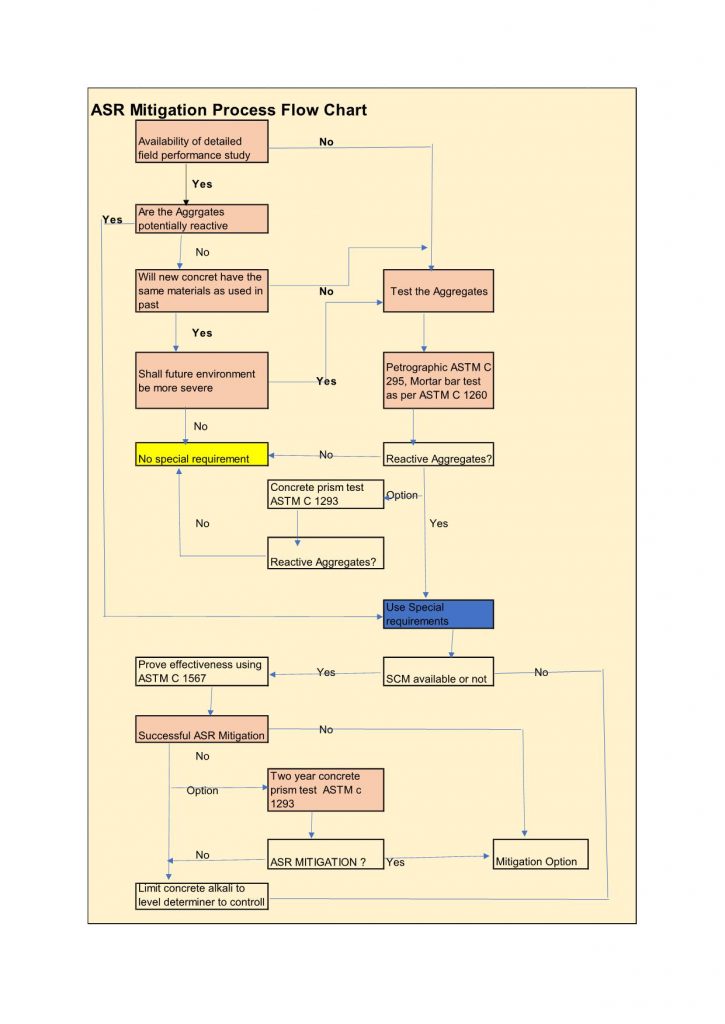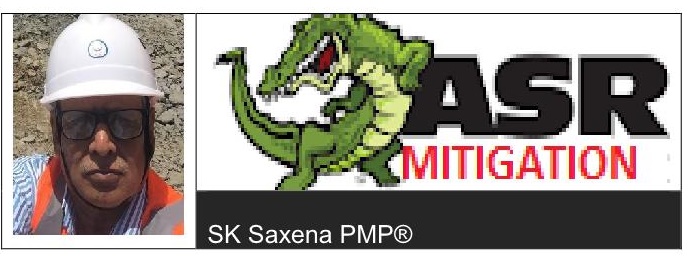Alkali Silica Reactivity- Indian Sub-Continent (General)
The Indian sub-continent has no definite history of the presence of deleterious material as silica, however the irrigation structures built around 1960, later showed sign of ASR at some places.
IS 2386-7 (1963): Methods of Test for Aggregates for Concrete, Part VII: Alkali Aggregate Reactivity [CED 2: Cement and Concrete] (reaffirmed 2002 and amended 2009), provides test methods for mortar bar test and chemical method, and there is no further mention in the code about the advanced testing methodology. It is true that aggregates are non-reactive as per petrographic examination, but considering the durability aspects, ASR must be given full attention with effective and efficient means of exploration to avoid haste in the construction.
Please refer to Alkali Silica Reactivity
BIS – IS 456 (2000): Plain and Reinforced Concrete – Code of Practice [CED 2: Cement and Concrete]- Fourth revision, Amended. May 2013, clause 8.2.5.4 ‘Alkali-aggregate reaction’ guides as follows: (Reproduced from the code)
“Some aggregates containing varieties of silica may be susceptible to attack by alkalis (N~O and ~O) originating from cement or other sources, producing an expansive reaction which can cause cracking and disruption of concrete. Damage to concrete from this reaction will normally only occur when all the following are present together:
a) A high moisture level, within the concrete.
b) A cement with high alkali content, or another source of alkali.
c) Aggregate containing an alkali reactive constituent.
Where the service records of particular cement aggregate combination are well established, and do not include any instances of cracking due to alkali aggregate reaction, no further protections should be necessary.
When the materials are unfamiliar, precautions should take one or more of the following forms:
a) Use of non-reactive aggregate from alternate sources.
b) Use of low alkali ordinary Portland cement having total alkali content not more than 0.6 percent (as Na20 equivalent). Further advantage can be obtained by use of fly ash (Grade 1) conforming to IS 3812 or granulated blast furnace slag conforming to IS 12089 as part replacement of ordinary Portland cement (having total alkali content as Na20 equivalent not more than 0.6 percent), provided fly· ash content is at least 20 percent or slag content is at least 50 percent.
c) Measures to reduce the degree of saturation of the concrete during service such as use of impermeable membranes,
d) Limiting the cement content in the concrete mix and thereby limiting total alkali content in the concrete mix. For more guidance specialist literatures may be referred.”
The above guidance needs to be further exhaustive in view of the updated research going on throughout the ASR affected regions of world such as:
Australia, Belgium, Canada, France, Germany, New Zealand, United Kingdom, United States
These are all developed countries. There are developing and underdeveloped countries such as in Africa, where they are following the ASTM methods for testing. RILEM in Europe is doing the equally good job to mitigate ASR and have the necessary guidelines. But it is also true that even after doing a series of advocated tests, the necessary confidence level is not built up. And therefore, it is necessary to go for tests as suggested by the developed countries and star using them at the project laboratory in comprehensive manner.
An ASR Test Flow Chart based on ASTM is given below, which may also be customised about the other organisation’s guidance. It is well known that the rocks are of heterogeneous nature ( difficult to ascertain reactive nature on sample basis) and the ASR symptoms are slow to appear, but when they do occur, they reduce the life of structures considerably and increase maintenance cost.
ASR Flow chart
A suggestive flow chart given below may be used as guidance for control of ASR

ASR outcomes are visible after some time. It may take 10 to 15 years depending upon the severity of the reaction. Dedicated and timely efforts are needed in exercising control efforts. The flow chart above can be interpreted as below:
1– If the history reports of the aggregate behaviour in the area shows reactive aggregates, go to Blue box for special treatment
2- If the aggregates are not reactive and can withstand environment concerns, they can be used as per Yellow box
3- If there is no history records or of the aggregates study and environmentally unsafe they should be tested as per ASTM C 295 (C295 / C295M-19 Standard Guide for Petrographic Examination of Aggregates for Concrete petrographic examination) and ASTM C 1260 (C1260-14 Standard Test Method for Potential Alkali Reactivity of Aggregates (Mortar-Bar Method) length change), and if found non-reactive can be used as shown by yellow box.
4- If during test the aggregates are found reactive, there is further option to test as per ASTM C 1293 (Standard Test Method for Determination of Length Change of Concrete Due to Alkali-Silica Reaction. Active Standard ASTM C1293) and if not found reactive, these can be used as per yellow box
5- If the historically and as per test as per S No 4, aggregates are found reactive, special required efforts are done and this revolve around the use of SCM (Supplementary Cementitious Materials) by partially replacing the cement contents. If no SCM use is administered, then other method used is to control the harmful alkali contents in material and use HPC and UHPC (reduction of alkali contents is of prime importance).
6- If SCM can be used, tests should be carried out as per ASTM C 1567, (C1567-13 Standard Test Method for Determining the Potential Alkali-Silica Reactivity of Combinations of Cementitious Materials and Aggregate) if found non-reactive , the aggregates can be used.
7- If found reactive as per test carried out as per S No 6, the material must be testes for long term prism test for about 2 years as per ASTM C 1293.( Standard Test Method for Determination of Length Change of Concrete Due to Alkali-Silica Reaction. Active Standard ASTM C1293) If found non-reactive these can be used. If found reactive, the procedure mentioned as per S No 5 highlighted may be used.
So, it is noticed that the guideline does not reject the aggregates instantly but provide further guidance not to reject till they are considered not suitable for constructi.

